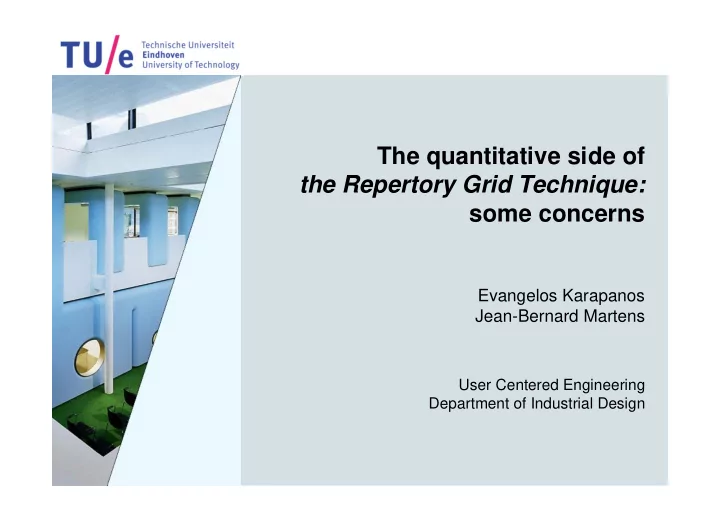

The quantitative side of the Repertory Grid Technique: some concerns Evangelos Karapanos Jean-Bernard Martens User Centered Engineering Department of Industrial Design
The Repertory Grid Technique (RGT) • Triading: “ what makes two of the products similar and different from the third ?” • Beauty – Ugly • Simple – Complicated • Rating: Give a score from 1 to 7 for product X on the scale Complicated - Simple The RGT Diversity Bipolarity Paired-
Accounting for Diversity Qualitative RGT We should be here! Quantitative RGT idiosyncratic average •Interact ’07 Diversity across subjects •CHI ’08 (subm) Diversity across views The RGT Diversity Bipolarity Paired-
On the bipolarity of constructs • Do people think in bipolar terms? – Subjects often need to be probed to derive a truly bipolar construct – Lyons (1977), “ categorizing experience in dichotomous contrast is a universal tendency which is only secondarily reflected in language ” • Negation (e.g. secure – insecure) • Opposition (e.g. professional – amateur) • Non-contiguous (e.g. easy – powerful) Table 1. Percentages of construct types from Karapanos & Martens, and Hassenzahl & Wessler studies. Type [ Kar] [ Has] R 2 Construct Negation (e.g. secure – insecure) 67% 35% Negation Opposition (e.g. professional – amateur) 17% 26% Secure - I nsecure 0.88 Practical - Impractical 0.86 Non-contiguous (e.g. easy – powerful) 16% 39% Opposition •Inspirational (formative) � Non-contiguous Creative - Standard 0.75 •Evaluative (summative) � Negation Professional – Amateur 0.90 The RGT Diversity Bipolarity Paired-
Measurement Scales Semantic Differential: Rate product A on the following dimensions Paired Comparison: Compare how beautiful the products are Ugly 1 2 3 4 5 6 7 Beautiful Product A 3 2 1 0 1 2 3 Product B De Ridder (1996) The RGT Diversity Bipolarity Paired-
Thank you! Evan http://www.idemployee.id.tue.nl/e.karapanos/
Recommend
More recommend